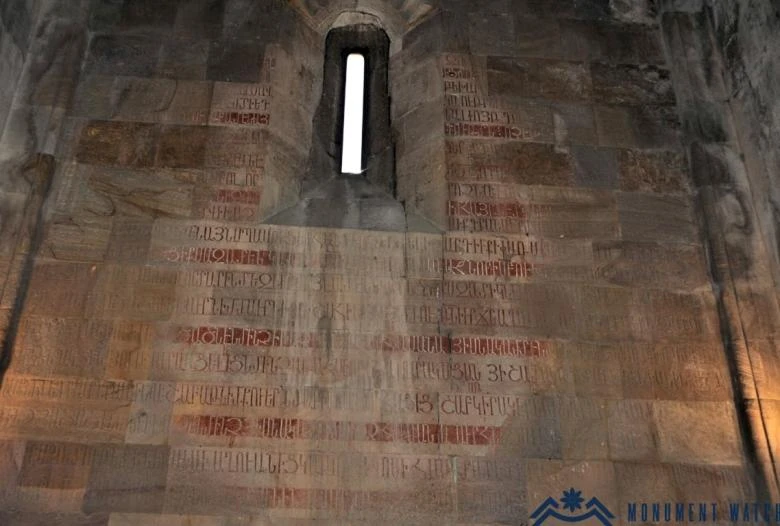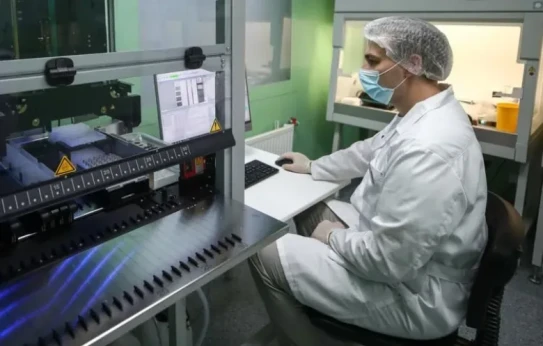Monument Watch warns:
History falsifier Rizvan Huseynov recently visited occupied Artsakh and shot a series of videos in Gandzasar, Dadivank and Amaras monastery complexes (https://www.youtube.com/watch?v=UepIvPZPP10, https://www.youtube.com/watch?v =vq_FGVt-PC0). Huseinov voiced the main Azeri propaganda thesis, according to which the Armenians allegedly spoiled the historical appearance of those monasteries, Armenianized them, transformed them. This thesis, of course, is not new and has been voiced for the last four years and constantly repeated in almost all Azerbaijani media. In September 2024, Huseinov chose the three most famous monasteries of Artsakh as a target, showing the "damages caused by Armenians".
In fact, we see the localization of the propaganda thesis, the installation on the monument itself, where every detail is considered within the framework of this thesis. The choice of the three most famous and famous monasteries of Artsakh is not accidental. These monasteries, especially Gandzasar and Amaras, were targeted by the Azerbaijani side after the September 2023 war, when Artsakh was completely occupied and the aforementioned Rizvan Huseynov made a special reference to these monuments (see Gandzasar expropriation has begun). From these videos, we can state that the monks of Gandzasar and Amaras the territory of the complexes is closed for visits, the entrances are sealed and locked. It is obvious that the Azerbaijani side gives a special place to these monasteries in their propaganda, but does not allow its citizens to visit them. In Gandzasar Monastery (https://www.youtube.com/watch?v=UepIvPZPP10) Huysenov states that the inscriptions on the walls of the church were allegedly added by Armenians and this forgery was done in the last hundred years.
Note that St. On the outer facades of the Hovhannes-Mkrtich Church and the vestibule, there are dozens of inscriptions of a donation nature, which contain enormous information about the political, spiritual, and economic realities of medieval Artsakh, and calling them false is a direct violation of the real history of the region. Speaking about the external walls of the church, it is noted that the facing stones adjacent to the red in the wall are new and were brought from Armenia and particularly from Etchmiadzin and testify to the attempts of Armenianization of the church.
According to Huseinov, the only undamaged inscription is the construction inscription inside the church, the fantastic version of which is deciphered by Huseinov. Accordingly, we see that the monastery was built by the Turkic governor of Khachen, Hasan-Jalal, who "accepted Armenian cohabitation". It is said about the wives of Hasan-Jalal and that the inscription allegedly mentions the people from Aghvan, the leader of the church from Aghvan and a certain Kochu Bey. These propagandistic hoaxes are remarkable for their utter stupidity. Gandzasar Monastery is one of the most researched monuments of Artsakh, there are many photos of the monastery, including those taken in the 19th century, where the intact walls and inscriptions of the church can be seen. It would be good if Huseinov got to know all this. Gandzasar monastery records have been published many times, including during the Soviet years, when research works could not be carried out in the area without the official permission of Soviet Azerbaijan.
There is a large volume of foreign language literature about the monastery, the monastery has been repeatedly referred to by foreign authors. The record of the construction of the church is also in its correct place, it is simply stupid to present it as published and modified many times. It is impossible to call the products of such thought otherwise. It would also be good if Huseinov decided who Hasan-Jalal is in the end and mentioned in what language the construction protocol was written. It is surprising that in one case the extensive Armenian inscription is considered historical, and the ones next to it are considered fake. We would also advise Huseinov to better familiarize himself with the creed of the Armenian Apostolic Church. We post our team's articles about Gandzasar, where you can find links to many articles and books about the monastery. It would be good if Huseinov read this (Gandzasar monastery: general information, Gandzasar St. Hovhannes Mkrtich Church, Gandzasar St. Hovhannes Mkrtich Church dome and sculptural compositions, Gandzasar courtyard and secular buildings, Gandzasar cross stones and tombstones).
The next monument, where Huseinov flashes his thoughts, is Dadivank (https://www.youtube.com/watch?v=vq_FGVt-PC0). In particular, the Catholic church of Dadivank, which was built in 1214 by Arzukhatun, the wife of Prince Vakhtang of Haterk, became the target of the forger. Huseinov considers the extensive construction record carved on the southern facade of the church, the high sculptures and the multi-colored composition, which, according to the forger, was made with stones brought from Echmiadzin in the last decade, to be fake. It is noticeable that if under the theses of "Armenianization, falsification" of many monuments of Artsakh, the guilt of the "Armenian side, the Armenians" is discussed, then in the case of Gandzasar, Dadivank and Amaras, the Azerbaijani side directly blames the official Etchmiadzin and according to this, Armenian To the Apostolic Church, which is almost not noticed in the case of other monuments. It is obvious that Huseinov does not know the architectural school of the region, because the vestibule built with rough stones and without cladding believes that it was not restored on purpose, so it looks like that. Huseinov does not understand the difference between a vestibule and a church, because he presents the vestibule as a church.
For some reason, the worldly, economic, and auxiliary structures of the monastery are presented as the oldest structures of the monastery, which the forger is not aware of. However, one of the gems of Rizvan Huseinov's mind is that the construction of the monastery is connected with Prince Hasan-Jalal, the other gem of thought refers to the Catholic Church. to the frescoes, which are declared to be early medieval, despite the fact that Huseynov dates the church where the frescoes are located to the 13th century. In Dadivank, Huseynov presents the Albanian church as two-story. When talking about the preservation of Dadivank, it would be good to remind Huseynov that during the Soviet years the monastery was shabby and half-ruined. was in a state as a result of the policy of Soviet Azerbaijan. This is evidenced by photographs of the monastery taken during the Soviet years.
Let us also remind Huseinov that the inscriptions of the monastery were researched during the Soviet years, which could not have been done without the permission of the Soviet authorities of Azerbaijan, that is, in the Karvachar region, which was depopulated and resettled by Kurds and Azerbaijanis, who, with the permission of the central and regional authorities, destroyed a significant part of the monuments in the region. and bring Dadivank to the brink of destruction. On this topic, see: Dadivank complex. general information, Dadivank. About Saint Dadi and his tomb, Dadivank Catholic Church and related structures, Dadivank small domed church, bell tower, khachkars and chapels, Dadivank secular monument group.


